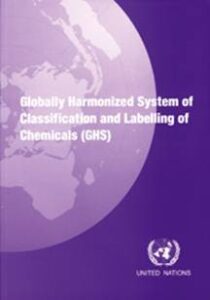 What is GHS
What is GHS
- Defining health, physical and environmental hazards of chemicals;
- Creating classification processes that use available data on chemicals for comparison with the defined hazard criteria; and
- Communicating hazard information, as well as protective measures, on labels and Safety Data Sheets (SDS).
What You Need to Do
If you use, handle, store chemicals in your workplace, you have until the end of this year (December 1) to train employees about the new GHS-compliant chemical labels and safety data sheets (SDSs). The deadline for training is December 1, 2013. Below is a review of what training your employees will need for you to stay compliant…
Safety Data Sheets
- Section 1—Identification—includes product identifier, manufacturer or distributor name, address, phone number, emergency phone number, recommended use, and restrictions on use
- Section 2—Hazard(s) identification—includes all hazards regarding the chemical and required label elements
- Section 3—Composition/Information on ingredients—includes information on chemical ingredients and trade secret claims
- Section 4—First-aid measures—includes important immediate or delayed symptoms of exposure to a chemical and the required first aid treatment
- Section 5—Fire-fighting measures—lists suitable extinguishing techniques, equipment, and chemical hazards from fire
- Section 6—Accidental release measures—lists emergency procedures, protective equipment, and proper methods of containment and cleanup
- Section 7—Handling and storage—lists precautions for safe handling and storage, including incompatibilities
- Section 8—Exposure controls/Personal protection—lists OSHA’s permissible exposure limits (PELs), threshold limit values (TLVs), appropriate engineering controls, and personal protective equipment (PPE)
- Section 9—Physical and chemical properties—lists the chemical’s characteristics
- Section 10—Stability and reactivity—lists chemical stability and possible hazardous reactions
- Section 11—Toxicological information—includes routes of exposure (inhalation, ingestion, or absorption contact), symptoms, acute and chronic effects, and numerical measures of toxicity
- Section 12—Ecological information—how the chemical might affect the environment and the duration of the effect
- Section 13—Disposal considerations—describes safe handling of wastes and methods of disposal, including the disposal of any contaminated packaging
- Section 14—Transportation information—includes packing, marking, and labeling requirements for hazardous chemical shipments
- Section 15—Regulatory information—indicates regulations that apply to chemical
- Section 16—Other information—includes date of preparation or last revision
Labels
- Product identifier gives a name or number that enables you to identify the chemical and cross-reference the label to the SDS.
- Supplier information tells you the name, address, and phone number of the manufacturer, importer, or other responsible party.
- First aid information can help you act quickly and effectively in an emergency.
- In case of fire, the label tells you how to extinguish it.
- Signal word indicates the severity of the hazard.
- Hazard statements describe the nature of the hazards.
- Pictograms convey specific hazard information using symbols or graphics.
- Precautionary statements describe recommended measures to minimize or prevent injury or illness due to exposure to the chemical or from improper handling or storage.
Timetable for Compliance with All GHS Requirements
Below is a timetable for compliance with all GHS requirements. After June 1, 2016 you will need revise your hazard communication plan to bring it into compliance with new hazard communication rules. But now are focus is on the compliance calendar.
Compliance Calendar
November 30, 2013
All employers that use, handle, store chemicals Train employees how to read and interpret chemical labels and (material) safety data sheets in compliance with either…
- The pre-GHS HazCom standard for labels and MSDSs; or
- The revised HazCom standard with GHS for new-style labels and SDSs; or
- Both old and new requirements at the same time
December 1, 2013
All employers that use, handle, store chemicals Train employees about the new GHS-compliant chemical labels and SDSs.
June 1, 2015
Chemical manufacturers, importers, distributors Comply with all the requirements of the GHS rule, including classify chemical hazards and prepare new labels and SDSs. Distributors have until December 1, 2015 to comply with the shipping requirements for GHS-compliant labels.
December 1, 2015
All employers that use, handle, store chemicals All shipments of chemical containers must include the new GHS-compliant label (signal word, pictogram, hazard statement, and precautionary statement).
June 1, 2016
All employers that use, handle, store chemicals Update alternative workplace labeling and hazard communication program as necessary, and provide additional employee training for newly identified physical or health hazards.
Need someone to help you with your compliance?
Contact Us (859-689-9222 – KY, 513-367-4100 – OH)
To get more information about how we can help your business.
 About Environmental Risk Management
About Environmental Risk Management
1-Source Turnkey Environmental & Safety Services
Since 1989, Environmental Risk Management has been providing responsive, client focused 1-source turnkey solutions for a wide variety of environmental safety challenges. With our experience and extensive network of diverse internal and external resources, our clients trust us to provide quality Environmental & Safety Services for their businesses. Our environmental compliance specialists recognize the need to consult with private industry and the business community and our goal is to ensurer our client’s are complying with complex environmental regulations and minimizing their environmental liabilities.
> Learn More
